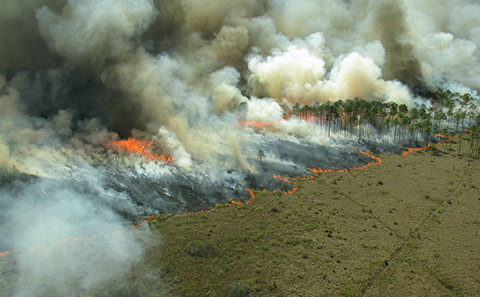Extreme weather events combined with rising environmental stress levels are increasing the likelihood of ecosystem collapse, according to new research.
A new study published in Nature Sustainability describes a “perfect storm” of continuous stress from factors such as unsustainable land use, agricultural expansion and climate change, coupled with extreme weather events, like floods and wildfires. Researchers say this combination could tip ecosystems into collapse sooner than previously thought.
Using computer modelling, researchers looked at four under threat ecosystems to work out what factors might lead to ‘tipping points’, beyond which collapse was inevitable. In some ecosystems, adding new extreme events on top of other ongoing stresses brought the timing of a predicted tipping point closer to the present day by as much as 80%.
“Previous studies of ecological tipping points suggest significant social and economic costs from the second half of the 21st century onwards,” says the study’s co-author Professor John Dearing, from the University of Southampton. “Our findings suggest the potential for these costs to occur much sooner.”
The team looked at two lake ecosystems and two forestry examples, including the historic collapse of the Easter Island (Rapa Nui) civilisation, widely thought to have been the result of over-population combined with unsustainable exploitation of tree cover.
The models were run over 70,000 times for each ecosystem, with variables adjusted on each occasion. Up to 15% of collapses occurred as a result of new stresses or extreme events, even while the main stress was kept constant. In other words, even if ecosystems are managed more sustainably by keeping the main stress levels like deforestation constant, new stresses like global warming and extreme weather events could still tip them into a collapse.
“Over a fifth of ecosystems worldwide are in danger of collapsing,” said Professor Simon Willcock from Rothamsted Research and Bangor University, who co-led the study. “However, ongoing stresses and extreme events interact to accelerate rapid changes that may well be out of our control. Once these reach a tipping point, it’s too late.”
The number of extreme climate events has increased since 1980 and global warming even at 1.5°C will increase those numbers further. Scientists are concerned about possible knock-on effects as one collapsing ecosystem impacts on neighbouring ecosystems.
“In the past two years, the world has come together around the climate and ecological crises through the UN Climate Change and Biodiversity Conferences. But we should remember that the causes of the crises are interlinked – that they have already collided – and that inaction over both may result in dire consequences,” said Willcock.
An example is the UN’s International Panel on Climate Change (IPCC) estimate for a tipping point in the Amazon Forest prior to 2100. The new study suggests a breakdown may occur several decades earlier than predicted by the IPCC. For example, it is well known that the Amazon Forest is threatened by deforestation. However, it is easy to imagine how global warming and extreme climate events such as droughts and wildfires add to this stress. This may decrease the Amazon’s ability to generate its own rainfall, making it drier and more vulnerable – resulting in the ecosystem spiralling down in a doom-loop.
“All four of the ecological systems we looked at showed the same overall outcomes,” said co-author Dr Gregory Cooper from University of Sheffield. “This has potentially profound implications for our perception of future ecological risks. While it is not currently possible to predict how climate-induced tipping points and the effects of local human actions on ecosystems will connect, our findings show the potential for each to reinforce the other. Any increasing pressure on ecosystems will be exceedingly detrimental and could have dangerous consequences”







